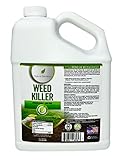We love artificial grass.
Not only does it look great all year long, artificial grass ultimately saves you time and money in the long-term with its low maintenance, long lasting nature.
However, if you want to keep it looking beautiful for longer, we need to take a look at weed control.
You’re probably thinking, hang on, weed control? How can weeds grow in my fake grass?
Well, they can and they will.
Essentially, it’s possible for weeds to grow through the small holes of the backing material of your fake grass, as well as in and around the edges. Depending on the type of infill you use as well, weeds can sometimes develop there.
But, never fear, we’ve got some expert tips for you in limiting any kind of weed movement and growth.
Let’s delve in.
What is the best weedkiller for fake grass?

There are two main types of weedkiller products: Contact Weedkillers and Systemic Weedkillers.
Contact weedkillers essentially cause damage whenever they come into contact with a plant. If you want to target weeds within a particular area, or perhaps even a particular type of weed, then a contact weedkiller is the product you want. They are most suitable for annual weeds as they help weaken the plant, destroying the green leafy part of the weed.
Systemic weedkillers, like the name suggests, systematically destroys the weed. When the leaves are sprayed, the weedkiller travels down through the weed to its roots, killing itself from within. It will kill all weeds, but is used typically for eliminating perennial weeds (weeds that are able to survive for many years).
Depending on the type of weeds that have grown in your artificial grass, the best weedkiller will be the one appropriate to your needs.
Using natural liquids

If however, you’re after a natural alternative solution to your weeds, there are a few things you could utilize.
- Boiling water
Yes, this is as simple as it sounds. Fill a kettle with some boiling water and pour it directly over the weeds in your artificial grass to kill them. Once the weeds have shriveled, you can easily pull them out and discard them. This method is great for ensuring there’s no damage or discolouration to your fake grass.
- Table salt
Any kind of salt will do for this. All you need to do is sprinkle it over the weed to prevent any kind of growth. This helps dehydrate the weeds and kill them. However, just make sure not to apply to the salt anywhere near concrete, bricks or paving stones as this can cause corrosion.
- Vinegar
How good is vinegar? This versatile product can be used in almost anything, from cooking to cleaning and now even, weed control. Fill a sprayer with vinegar and spray it all over your weeds to kill them. Vinegar is a great natural solution as it’s non-toxic and environmentally-friendly.
- Vodka
We all know that alcohol dehydrates us. This will give the same effect on weeds. Mix two cups of water with an ounce of vodka and spray the leaves for a natural solution that won’t damage your artificial grass.
Removing and preventing weed invasion

Now that we know how to remove weeds, let’s take a look at preventing growth in the first place.
The number one thing we recommend is to continue the upkeep. While you don’t have to mow the lawn with your artificial grass, we do suggest regularly raking away any debris, leaves and organic waste from its surface. Keep it clean and debris-free and you’ll essentially eliminate any room for weed growth.
Another point to keep in consideration is applying an annual weedkiller. You don’t need to do this often – once or twice a year is more than enough and will help keep weeds at bay.
While it does seem like a bit of work, it isn’t as much work a normal lawn would involve. It’s still minimal upkeep, for maximum gain!







